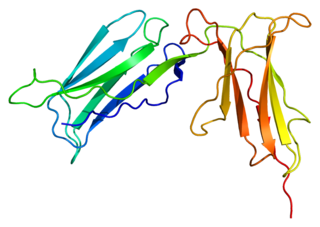
Leukocyte surface antigen CD53 is a protein that in humans is encoded by the CD53 gene.

MHC class I polypeptide–related sequence A (MICA) is a highly polymorphic cell surface glycoprotein encoded by the MICA gene located within MHC locus. MICA is related to MHC class I and it has similar domain structure, however, it is not associated with β2-microglobulin nor binds peptides as conventional MHC class I molecules do. MICA rather functions as a stress-induced ligand (as a danger signal) for integral membrane protein receptor NKG2D ("natural-killer group 2, member D"). MICA is broadly recognized by NK cells, γδ T cells, and CD8+ αβ T cells which carry NKG2D receptor on their cell surface and which are activated via this interaction.

Lymphotoxin-beta (LT-beta) also known as tumor necrosis factor C (TNF-C) is a protein that in humans is encoded by the LTB gene.

CD244 is a human protein encoded by the CD244 gene. It is also known as Natural Killer Cell Receptor 2B4

Killer cell immunoglobulin-like receptor 3DL1 is a protein that in humans is encoded by the KIR3DL1 gene.

Large proline-rich protein BAT3 is a protein that in humans is encoded by the BAT3 gene.

Natural cytotoxicity triggering receptor 3 is a protein that in humans is encoded by the NCR3 gene. NCR3 has also been designated as CD337 and as NKp30. NCR3 belongs to the family of NCR membrane receptors together with NCR1 (NKp46) and NCR2 (NKp44).

NKG2-F type II integral membrane protein is a protein that in humans is encoded by the KLRC4 gene.

Leukocyte immunoglobulin-like receptor subfamily B member 2 is a protein that in humans is encoded by the LILRB2 gene.

MAP kinase-activating death domain protein is an enzyme that in humans is encoded by the MADD gene.

Killer cell immunoglobulin-like receptor 3DL2 is a protein that in humans is encoded by the KIR3DL2 gene.

Large proline-rich protein BAT2 is a protein that in humans is encoded by the BAT2 gene.

Killer cell immunoglobulin-like receptor 2DS4 is a protein that in humans is encoded by the KIR2DS4 gene.

Leukocyte immunoglobulin-like receptor subfamily B member 3 is a protein that in humans is encoded by the LILRB3 gene.

Protein BAT5 is a protein that in humans is encoded by the BAT5 gene.

Leukocyte immunoglobulin-like receptor subfamily A member 2 is a protein that in humans is encoded by the LILRA2 gene.

Osteoclast-associated immunoglobulin-like receptor is a protein that in humans is encoded by the OSCAR gene.

NK-tumor recognition protein is a protein that in humans is encoded by the NKTR gene.

Leukocyte immunoglobulin-like receptor subfamily A member 4 is a protein that in humans is encoded by the LILRA4 gene.

Leukocyte immunoglobulin-like receptor subfamily B member 5 is a protein that in humans is encoded by the LILRB5 gene.












